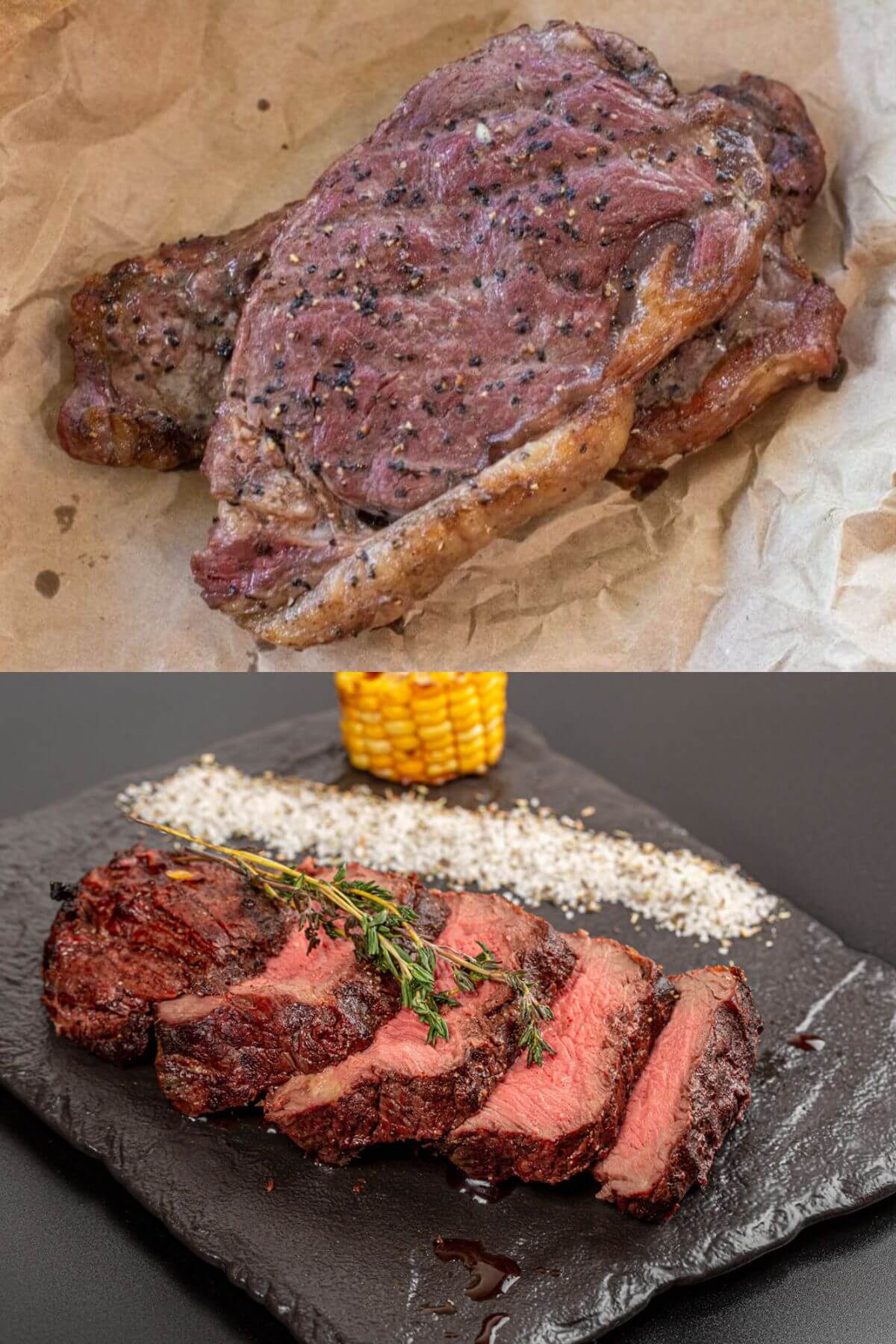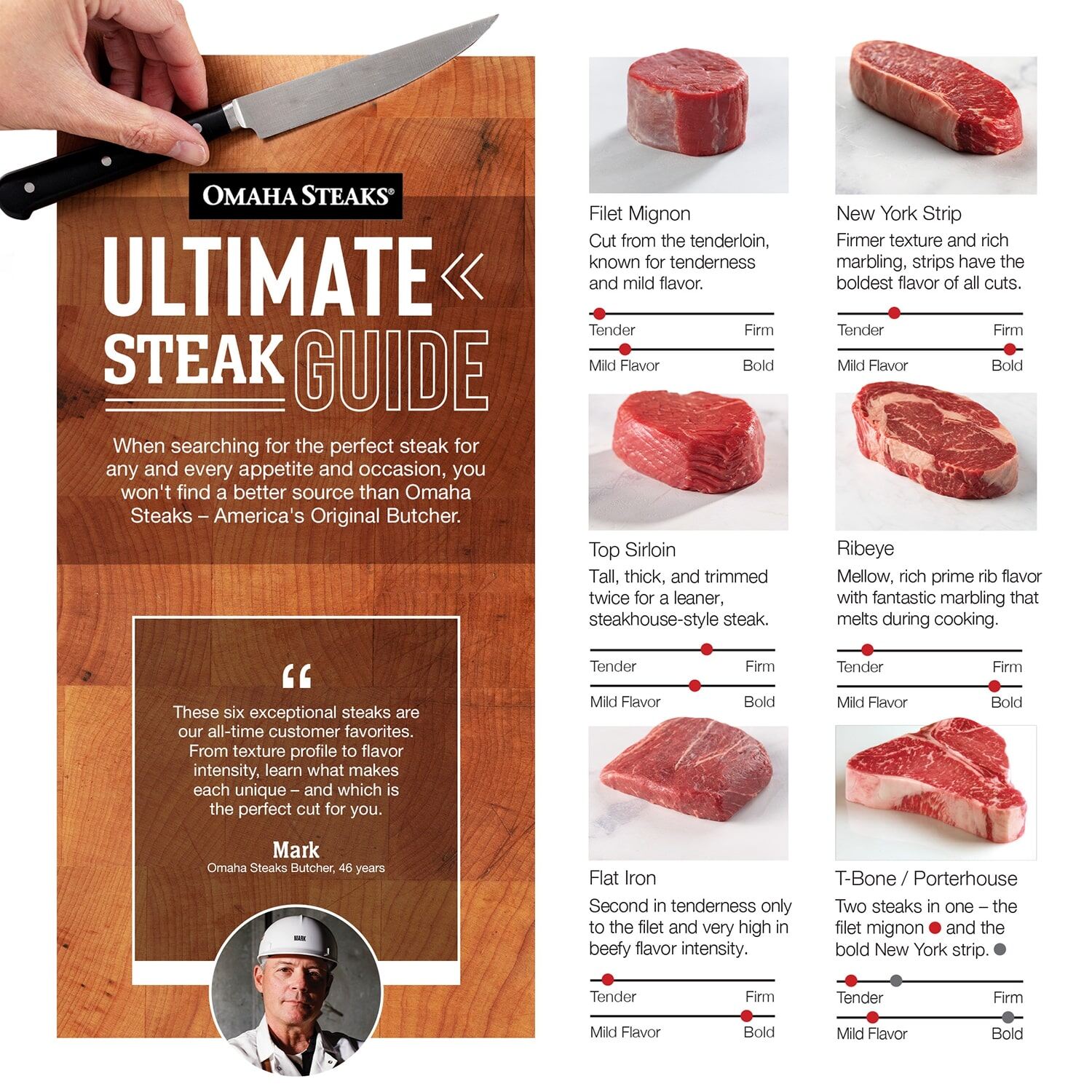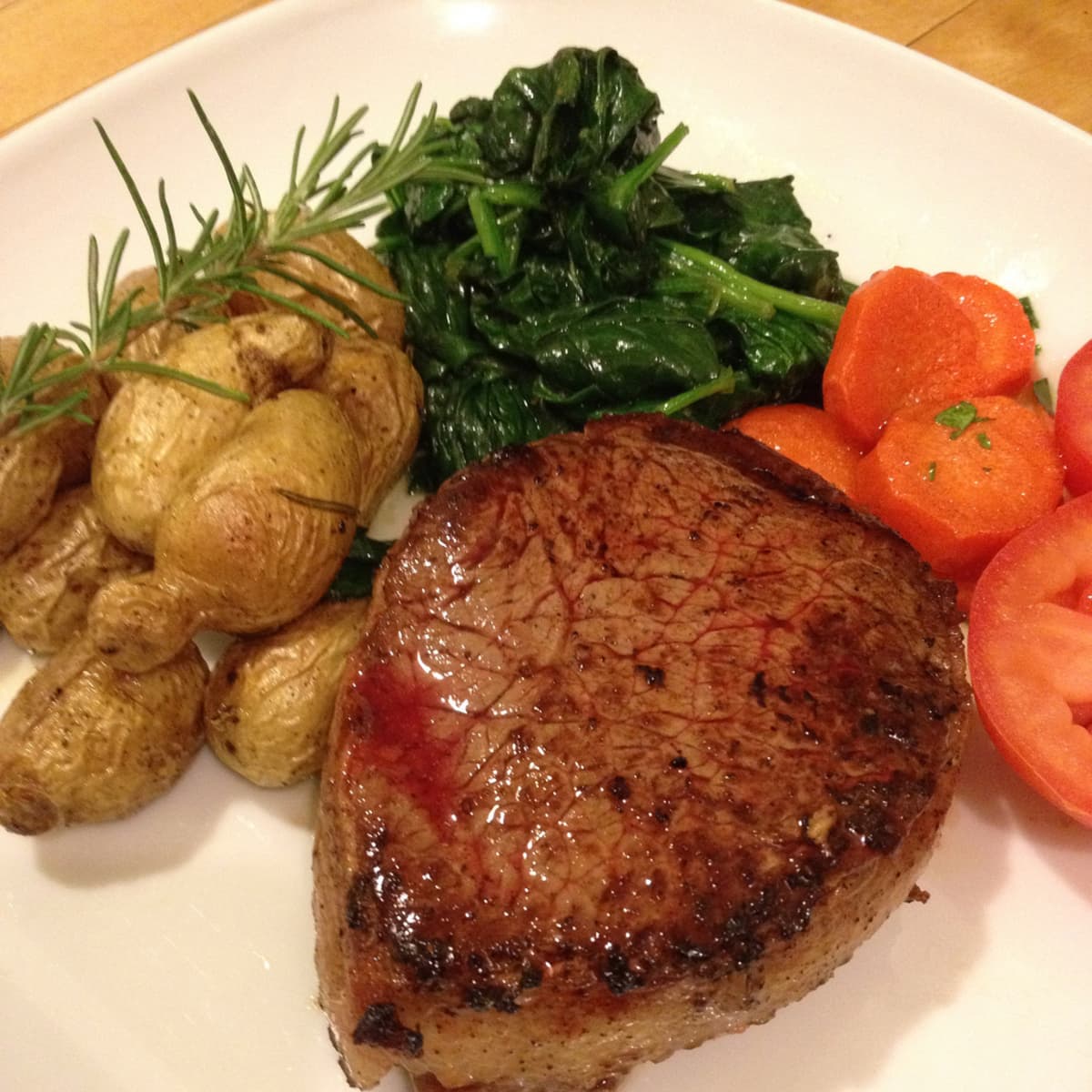
Introduction
Overview Of Filet Mignon And Sirloin As Popular Steak Cuts
Filet mignon and sirloin are two popular steak cuts that offer distinct flavors, textures, and portion sizes. Filet mignon is known for its tenderness and mild, buttery taste. It is often considered a high-end cut of beef and is highly esteemed among steak enthusiasts. On the other hand, sirloin has a beefy and robust flavor, making it a favorite for those who prefer a more intense beef taste.
Importance Of Understanding The Differences Between Filet Mignon And Sirloin
Before placing an order for steaks, it is crucial to understand the differences between filet mignon and sirloin. Making the right choice depends on your preferences for texture, flavor, and portion size. Here are some key factors to consider when comparing filet mignon and sirloin:
- Texture: Filet mignon is known for its exceptional tenderness, making it melt-in-your-mouth. On the other hand, sirloin is a bit denser and chewier in texture.
- Flavor: Both filet mignon and sirloin offer great beef flavor. However, top sirloin tends to have more marbling and fat content, resulting in a juicier and more flavorful steak.
- Portion Size: Filet mignon is typically smaller in size, making it a suitable choice for those who prefer smaller portions. Sirloin, on the other hand, is larger and can satisfy those with heartier appetites.
- Location on the Cow: Filet mignon is cut from the tenderloin, a muscle that is not heavily used, resulting in its tenderness. Sirloin comes from between the rump and the loin, making it a bit more flavorful due to the muscles being used more.
In conclusion, understanding the differences between filet mignon and sirloin is important in selecting the right steak for your preferences. Whether you value tenderness, flavor, or portion size, both cuts offer unique qualities that can satisfy any steak lover’s palate.
Filet Mignon: The Tenderloin Cut
Description And Location Of The Filet Mignon Cut
Filet mignon is a cut of steak that is known for its exceptional tenderness and delicate flavor. It is obtained from the tenderloin, which is a long, cylindrical muscle that runs along the spine of the cow. The tenderloin is not heavily used by the cow, resulting in the tenderness of the filet mignon. It is typically smaller in size compared to other cuts.
Characteristics And Tenderness Of Filet Mignon
Filet mignon is highly regarded for its melt-in-your-mouth tenderness. It is often described as being buttery and delicate in flavor. Due to its low fat content and minimal marbling, filet mignon may not have the same intense beefy flavor as some other cuts. However, the subtlety of its flavor appeals to those who prefer a more refined taste.
Despite its lack of fat, filet mignon remains juicy and tender when cooked properly. It is often recommended to cook it to medium-rare or medium to ensure the best texture. The tenderness of filet mignon makes it a prime choice for steak lovers who value a luxurious dining experience.
In comparison to other cuts like sirloin, filet mignon may not offer as robust of a flavor. However, its tenderness and delicate flavor make it a favorite among those seeking a refined steak encounter. It is often served with rich sauces or accompaniments to enhance its flavor profile.
In conclusion, filet mignon is a high-end steak cut that is prized for its exceptional tenderness and mild, buttery flavor. Its smaller portion size and delicate texture make it a favored choice for those who appreciate a refined steak experience.
Sirloin: The Versatile Cut
Description And Location Of The Sirloin Cut
The sirloin cut is known for its robust flavor and juicy tenderness. It is obtained from the sirloin section of the cow, which is located towards the back, just above the hindquarters. This section is divided into two parts: the top sirloin and the bottom sirloin. The top sirloin is the more tender and desirable portion, while the bottom sirloin is often used for ground beef or roasts.
Distinctive Features And Flavor Profile Of Sirloin
Sirloin steak has a bold, beef-forward flavor that appeals to those who enjoy a hearty steak experience. It has a good amount of fat marbling, which adds to its flavor and helps keep the meat moist during cooking. The texture of sirloin steak is firmer compared to the buttery tenderness of filet mignon.
In terms of cooking, sirloin steak is versatile and can be prepared in various ways. It can be grilled, pan-seared, or broiled to achieve a delicious medium-rare or medium doneness. Sirloin steak pairs well with simple seasonings and marinades that enhance its natural beef flavor.
When comparing sirloin to filet mignon, the main difference lies in the flavor and tenderness. Sirloin steak offers a more robust and beefy taste, making it ideal for those who prefer a stronger flavor profile. Its firmer texture also provides a satisfying chewing experience.
In conclusion, the sirloin cut is a versatile option for steak lovers who appreciate a hearty and flavorful dining experience. Its robust flavor, juicy tenderness, and firmer texture set it apart from the delicate and buttery filet mignon. Whether grilled, pan-seared, or broiled, sirloin steak is sure to satisfy the cravings of those seeking a satisfying beef-forward encounter.

Taste And Texture Comparison
Comparison Of The Taste And Texture Of Filet Mignon And Sirloin
Filet mignon and sirloin are both popular cuts of beef, but they differ in taste and texture. Here is a comparison of how these two cuts stack up against each other:
Taste:
- Filet Mignon: Filet mignon steaks have a more delicate taste that is still mouth-watering, but not quite as intense as the sirloin cut. They offer a mild and buttery flavor that is highly enjoyable.
- Sirloin: Sirloin steaks, on the other hand, have a bold and beef-forward flavor that appeals to those who enjoy a heartier steak experience. Its robust flavor profile is rich and satisfying.
Texture:
- Filet Mignon: Filet mignon is known for its exceptional tenderness and buttery texture. It practically melts in your mouth. The texture is tender and smooth, making it a favorite among many steak connoisseurs.
- Sirloin: Sirloin steak has a firmer texture compared to filet mignon. It offers more resistance when chewing, providing a satisfying and substantial bite.
Factors That Contribute To The Different Flavors And Textures
Several factors contribute to the different flavors and textures of filet mignon and sirloin:
- Location: Filet mignon is cut from the tenderloin area of the cow, which is a less-worked muscle that contributes to its tenderness and delicate flavor. Sirloin, on the other hand, is obtained from the sirloin section of the cow, which is located towards the back and is a more active muscle. This leads to a firmer texture and a bolder flavor in sirloin.
- Fat content: Filet mignon is known for its leanness and minimal fat content. This enhances its tenderness and contributes to its delicate flavor. On the other hand, sirloin has more fat marbling, which adds flavor and helps keep the meat moist during cooking.
- Cooking methods: While both cuts can be prepared using various cooking methods, the tenderness and texture of filet mignon make it more suitable for quick-cooking methods such as pan-searing or grilling. Sirloin can withstand a variety of cooking techniques and is versatile in terms of preparation.
In conclusion, while filet mignon and sirloin have their own distinct taste and texture, both cuts offer delicious and satisfying steak experiences. Filet mignon stands out for its delicate and buttery flavor, coupled with its melt-in-your-mouth tenderness. Sirloin, on the other hand, offers a robust beef-forward flavor and a firmer texture for those who prefer a heartier steak experience. Both cuts have their own unique qualities that are sure to please steak enthusiasts.
Culinary Uses Of Filet Mignon
Popular Cooking Methods And Recipes For Filet Mignon
Filet mignon is a versatile cut of beef that can be prepared using various cooking methods. Here are some popular ways to cook filet mignon:
- Pan-searing: Heat a skillet with some oil or butter on high heat. Sear the filet mignon for a few minutes on each side until a crust forms. Finish cooking in the oven.
- Grilling: Preheat the grill to high heat. Place the filet mignon on the grill and cook for about 4-5 minutes on each side for medium-rare doneness.
- Baking: Preheat the oven to 425°F. Season the filet mignon with salt, pepper, and any desired herbs or spices. Place it on a baking sheet and cook for about 10-12 minutes for medium-rare.
Aside from these cooking methods, filet mignon can also be used in a variety of recipes, such as:
- Beef Wellington: In this classic dish, filet mignon is wrapped in puff pastry with a layer of mushrooms, onions, and pâté.
- Steak Diane: Filet mignon is pan-seared and served with a sauce made from pan drippings, Worcestershire sauce, Dijon mustard, and cream.
- Surf and Turf: Pair filet mignon with seafood, such as lobster or shrimp, for a luxurious dining experience.
Tips For Cooking Filet Mignon To Perfection
To ensure you cook filet mignon to perfection, here are some tips to keep in mind:
- Bring the meat to room temperature before cooking to ensure even cooking.
- Season the filet mignon with salt and pepper just before cooking to enhance its natural flavors.
- Use a meat thermometer to check for doneness. For medium-rare, the internal temperature should be around 135°F.
- Let the cooked filet mignon rest for a few minutes before serving to allow the juices to redistribute.
Following these tips will help you achieve a perfectly cooked filet mignon every time, whether you prefer it medium-rare, medium, or well-done.
Culinary Uses Of Sirloin
Wide Range Of Cooking Options For Sirloin
Sirloin is a versatile cut of beef that offers a wide range of cooking options. Here are some popular cooking methods for sirloin:
- Grilling: Sirloin steaks are perfect for grilling. Preheat the grill to medium-high heat and season the steaks with salt and pepper. Cook the steaks for about 4-6 minutes on each side for medium-rare doneness.
- Roasting: Sirloin roast can be cooked in the oven for a delicious and tender result. Preheat the oven to 350°F. Season the roast with your desired herbs and spices, and roast it for about 15-20 minutes per pound until it reaches your desired level of doneness.
- Stir-frying: Sirloin can also be sliced into thin strips and stir-fried with vegetables for a quick and flavorful meal. Heat a skillet or wok on high heat, add some oil, and stir-fry the sliced sirloin for a few minutes until browned.
Grilling, Roasting, And Other Cooking Techniques For Sirloin
In addition to grilling and roasting, sirloin can be used in various other cooking techniques:
- Broiling: Place the sirloin steaks on a broiler pan and cook them under the broiler for about 4-6 minutes on each side for medium-rare doneness.
- Slow-cooking: Sirloin can be used in slow-cooked dishes such as stews and pot roasts. Cut the sirloin into cubes and cook it slowly in a flavorful liquid until it becomes tender and juicy.
- Kabobs: Cut the sirloin into cubes and thread them onto skewers with your favorite vegetables. Grill or broil the kabobs until the meat is cooked to your desired level of doneness.
Sirloin is a versatile cut that can be used in a variety of recipes, such as steak salads, fajitas, sandwiches, and stir-fries. Its bold flavor and firm texture make it a favorite among beef lovers.
Flavor Preference And Personal Choice
Understanding The Individual Preferences For Filet Mignon And Sirloin
When it comes to choosing between filet mignon and sirloin, personal preference plays a key role. Each cut offers unique characteristics that cater to different tastes. Here’s a closer look at the individual preferences for each cut:
- Filet Mignon:
- Texture: Filet mignon is known for its buttery texture. It is exceptionally tender and can be cut with a fork.
- Flavor: Filet mignon has a milder flavor compared to sirloin. Its delicate taste is often described as subtle and lean.
- Cooking Methods: Due to its tenderness, filet mignon is often best enjoyed when cooked quickly and at a high heat. Popular methods include grilling, pan-searing, or broiling.
- Sirloin:
- Texture: Sirloin has a firmer texture compared to filet mignon. It offers a satisfying chew and bite.
- Flavor: Sirloin is known for its bold beef flavor. It has a rich, savory taste that many beef enthusiasts appreciate.
- Cooking Methods: Sirloin is versatile and can be prepared using various techniques. It is excellent for grilling, roasting, stir-frying, broiling, slow-cooking, and even for making kabobs.
Factors That Influence The Choice Between The Two Cuts
Several factors come into play when deciding between filet mignon and sirloin:
- Tenderness: If tenderness is your top priority, filet mignon is the preferred choice. Its tender and buttery texture is unmatched.
- Flavor: If you prefer a bolder and more pronounced beef flavor, sirloin is the way to go. Its robust taste adds depth to any dish.
- Pricing: Filet mignon is often pricier compared to sirloin. If affordability is a concern, sirloin offers excellent value for money without compromising taste or quality.
- Cooking style: Consider your preferred cooking methods. Filet mignon lends itself well to quick and high-heat cooking, while sirloin excels in various techniques, including grilling, roasting, and stir-frying.
In the end, it all boils down to personal preference. Whether you prioritize tenderness, flavor, or cost, understanding the unique characteristics of filet mignon and sirloin will help you make an informed decision and ensure a memorable steak experience.

Nutritional Comparison
Nutritional Value And Composition Of Filet Mignon
Filet mignon is a lean cut of beef that offers several nutritional benefits. Here is a breakdown of its nutritional value and composition:
- Calories: Filet mignon is relatively low in calories, making it a good choice for those watching their calorie intake.
- Protein: It is a rich source of high-quality protein, which is essential for building and repairing tissues.
- Fat: Filet mignon is a lean cut of beef, meaning it contains less fat compared to other cuts. It typically has around 5 grams of saturated fat.
- Cholesterol: It contains about 95 milligrams of cholesterol, which is relatively low compared to some other cuts of beef.
- Vitamins and minerals: Filet mignon is a good source of iron, magnesium, and vitamin B12. These nutrients play important roles in maintaining overall health and well-being.
Nutritional Value And Composition Of Sirloin
Sirloin, another popular cut of beef, also offers several nutritional benefits. Here is a breakdown of its nutritional value and composition:
- Calories: Similar to filet mignon, sirloin is relatively low in calories.
- Protein: It is a good source of protein, which is important for muscle growth and repair.
- Fat: Sirloin contains a bit more fat compared to filet mignon, but it is still considered a lean cut of beef.
- Cholesterol: It has a similar cholesterol content to filet mignon, with about 95 milligrams.
- Vitamins and minerals: Sirloin is a good source of zinc, which is important for immune function and wound healing.
In summary, both filet mignon and sirloin offer nutritional benefits, but they differ slightly in terms of fat content and vitamin and mineral composition. Ultimately, the choice between the two cuts comes down to personal preference and dietary needs. It’s important to consider factors such as flavor, tenderness, and cooking methods when deciding which cut to include in your diet. Consulting with a healthcare professional or registered dietitian can also help you make an informed decision based on your specific nutritional requirements.
Conclusion
Summarizing The Differences Between Filet Mignon And Sirloin
In conclusion, filet mignon and sirloin are two distinct cuts of steak with their unique characteristics. Filet mignon offers a buttery texture, mild flavor, and exceptional tenderness, making it a popular choice for those seeking a luxurious and delicate dining experience. On the other hand, sirloin has a slightly firmer texture, bold beef flavor, and is more affordable.
Factors To Consider When Choosing Between The Two Cuts
When deciding between filet mignon and sirloin, there are several factors to consider:
- Texture: Filet mignon is known for its tender and melt-in-your-mouth texture, while sirloin has a slightly firmer texture.
- Flavor: Filet mignon tends to have a milder flavor, allowing the natural taste of the beef to shine through, while sirloin offers a bolder beef flavor.
- Price: Sirloin is generally more affordable than filet mignon, making it a popular choice for budget-conscious individuals.
- Cooking methods: Filet mignon is often cooked using dry heat methods, such as grilling or pan-searing, to preserve its tenderness. On the other hand, sirloin can withstand various cooking methods, including grilling, broiling, or roasting.
- Nutritional composition: Filet mignon is a lean cut of beef that is relatively low in calories and saturated fat. It is also a good source of high-quality protein and essential vitamins and minerals. Sirloin, although slightly higher in fat compared to filet mignon, is still considered a lean cut of beef and offers similar nutritional benefits.
Ultimately, the choice between filet mignon and sirloin comes down to personal preference, budget, and dietary needs. Both cuts offer great beef flavor and can be enjoyed in various dishes. It is essential to consider factors such as texture, flavor, cooking methods, and nutritional composition when making your decision. Consulting with a healthcare professional or registered dietitian can also help you make an informed choice based on your specific nutritional requirements.
FAQ: Filet Mignon vs Sirloin – Beef Steak Showdown
Q: What is Filet Mignon?
A: Filet Mignon is a highly prized cut of beef steak that is taken from the smaller end of the tenderloin. It is known for its exceptional tenderness and melt-in-your-mouth texture.
Q: What is Sirloin?
A: Sirloin is a popular beef steak cut that comes from the area behind the ribs and extends to the hip bone. It is generally leaner than other cuts and is known for its rich, beefy flavor.
Q: How do Filet Mignon and Sirloin differ in terms of taste?
A: Filet Mignon is often described as having a mild and delicate flavor. Its tenderness is its main appeal, but compared to Sirloin, it may have a less pronounced beefy taste. On the other hand, Sirloin offers robust flavor with a slightly firmer texture.
Q: Which cut is more tender, Filet Mignon or Sirloin?
A: Filet Mignon is widely regarded as one of the most tender cuts of beef available. Its tenderness comes from the fact that it is a muscle that does less work and contains less connective tissue. Sirloin, while still relatively tender, may require a little more chewing due to its higher content of connective tissue.
Q: How do Filet Mignon and Sirloin compare in terms of price?
A: Filet Mignon is generally more expensive than Sirloin due to its tender and sought-after nature. The limited quantity of Filet Mignon available per animal contributes to its higher price tag. Sirloin, being a larger and more versatile cut, tends to have a more wallet-friendly cost.
Q: Which cooking methods are best for Filet Mignon and Sirloin?
A: Filet Mignon is often grilled or pan-seared to retain its tenderness and enhance its flavor. It is commonly cooked to medium-rare or medium to prevent drying out. Sirloin, on the other hand, is well-suited for grilling, broiling, sautéing, or even roasting. It can be cooked to various degrees of doneness, depending on personal preference.
Q: Can Filet Mignon and Sirloin be used interchangeably in recipes?
A: Filet Mignon and Sirloin have distinct characteristics, both in terms of tenderness and flavor. While they can both be delicious in their own right, it is best to choose the cut that complements the specific recipe. Filet Mignon is often used for elegant dishes, while Sirloin is more versatile and can be used in various recipes, including stir-fries, stews, and sandwiches.
Q: Are Filet Mignon and Sirloin suitable for different occasions?
A: Filet Mignon, being a premium and more expensive cut, is often associated with special occasions, romantic dinners, or fine dining experiences. Sirloin, with its robust flavor and versatility, can be enjoyed on more casual occasions or as an everyday steak option.
Remember, personal preference plays a significant role in choosing between Filet Mignon and Sirloin. The tenderness of Filet Mignon and the rich flavor of Sirloin each have their own devoted fans. Ultimately, the choice boils down to your individual taste, cooking method, and budget.

We are family-owned and operated. We love to serve coffee to our community that loves to drink it! We opened in December 2017 and are always expanding and evolving. We strive to offer a relaxing and comfortable gathering place for our customers. We not only serve delicious coffee but a full breakfast and lunch menu as well. You can also order ONLINE through our website or call ahead and pick it up right at our drive-thru window! We have a wide range of delicious baked goods, sweet treats, and a gift shop coming soon! Stop in and let us serve you!!